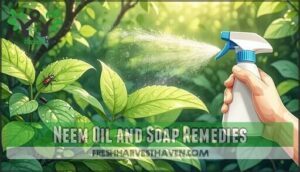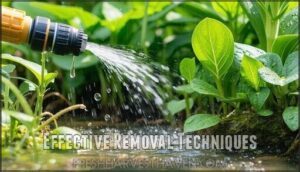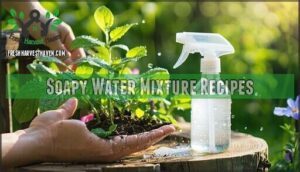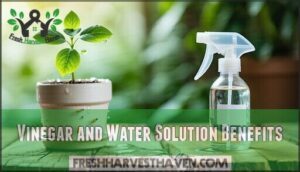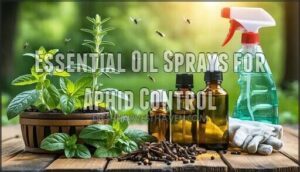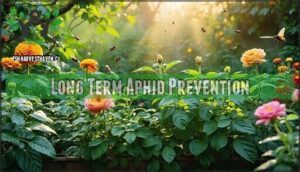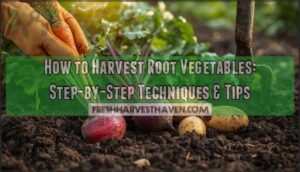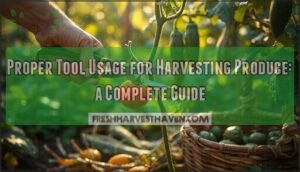This site is supported by our readers. We may earn a commission, at no cost to you, if you purchase through links.
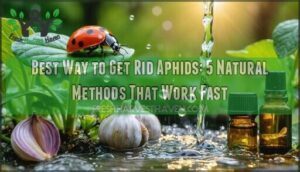 The best way to get rid aphids is to combine natural methods that pack a punch. Start by blasting them off with a strong jet of water—think of it as their surprise eviction notice.
The best way to get rid aphids is to combine natural methods that pack a punch. Start by blasting them off with a strong jet of water—think of it as their surprise eviction notice.
Next, use a garlic or neem oil spray to disrupt their feeding and reproduction. If you’re feeling hands-on, squish clusters or prune heavily infested leaves.
Introducing ladybugs is like hiring tiny pest control experts. These steps keep your plants safe without harsh chemicals.
Remember, consistency is key—aphids multiply fast. Stick around for some tried-and-true recipes and simple prevention tricks that’ll keep your garden thriving.
Table Of Contents
- Key Takeaways
- Identify Aphid Infestation
- Natural Aphid Control Methods
- Effective Removal Techniques
- Homemade Aphid Remedies
- Long Term Aphid Prevention
- Frequently Asked Questions (FAQs)
- What is the fastest way to get rid of aphids?
- Will Dawn and vinegar kill aphids?
- What is the best homemade aphid killer?
- What do aphids hate the most?
- How do I get rid of aphids?
- How can I manage my hives?
- How can I prevent aphids from building up in my garden?
- Can you get rid of aphids in summer?
- How do you get rid of aphids on grass?
- How to control aphid infestation in trees?
- Conclusion
Key Takeaways
- Start with water blasting – Use a strong hose spray to immediately knock aphids off your plants, then follow up with garlic or neem oil sprays to disrupt their feeding and prevent them from returning.
- Introduce beneficial predators – Release ladybugs and lacewings in your garden since each ladybug larva can consume 400 aphids during development, providing natural long-term control.
- Apply homemade soapy water consistently – Mix 1-2 teaspoons of dish soap per liter of water and spray every 3-5 days, targeting leaf undersides where aphids cluster.
- Combine removal with prevention – Hand-pick heavily infested areas, prune damaged stems, and use row covers or reflective mulch to prevent future infestations from establishing.
Identify Aphid Infestation
Before you can tackle an aphid problem, you need to spot the signs early.
Look for clusters of small, soft-bodied insects on new growth, yellowing leaves, and sticky honeydew residue that attracts black sooty mold.
Signs of Aphid Damage
Aphid damage signs appear as distorted growth patterns on your plants.
Twisted stems and stunted growth are your plant’s silent SOS for aphid trouble.
You’ll spot plant deformation through twisted stems and stunted development.
Leaf curling creates distinctive wrinkled patterns where aphids feed on plant sap.
Look for sticky honeydew trails coating leaves and stems.
This sugary secretion attracts sooty mold, creating black patches that block photosynthesis and weaken plants further.
Understanding natural aphid control is essential to prevent such damage and promote healthy plant growth, which can be found at natural aphid control, and recognizing aphid damage signs and sticky honeydew trails.
Visible Symptoms of Infestation
Looking beyond damaged leaves, you’ll spot clusters of tiny, soft-bodied insects on stems and leaf undersides.
These pear-shaped pests range from green to black, often appearing wingless. Watch for curled or distorted leaves showing plant deformity – classic infestation signs.
You might notice sticky honeydew trails coating surfaces below affected plants, creating perfect conditions for sooty mold development later, which can be a result of the infestation.
Honeydew and Sooty Mold Effects
You’ll notice sticky honeydew damage coating your plants like nature’s unwanted syrup.
This sugar excretion from aphids creates perfect conditions for sooty mold—a black fungal growth that blocks sunlight and weakens plants.
The combination triggers plant diseases and reduces photosynthesis. Getting serious about organic pest control means tackling both the aphids and their messy aftermath to prevent long-term damage.
Natural Aphid Control Methods
When you’re facing an aphid invasion, natural control methods offer effective solutions without harsh chemicals.
These biological approaches target aphids at multiple life stages while preserving beneficial insects that help maintain garden balance.
Garlic Spray Solution
Among your arsenal of organic pest control methods, garlic spray stands out as nature’s own pesticide.
This powerful pest deterrent harnesses garlic benefits through sulfur compounds that disrupt aphid feeding.
Mix three crushed garlic bulbs with water, strain, and spray every few days.
These natural aphid killers reduce populations by 70% while remaining safe for beneficial insects, making it an excellent organic pesticide choice.
The use of garlic pest spray solutions often involves understanding garlic pest control methods to maximize effectiveness.
Neem Oil and Soap Remedies
You can fight back against aphids with two powerhouse natural pesticides that deliver knockout results. Neem oil benefits include disrupting their feeding and reproduction, while soap spray suffocates these pests on contact.
Mix oil concentrate properly for maximum effectiveness. Understanding the proper use of Neem Oil Spray is essential for effective aphid control.
- Apply 0.5%-1% neem oil solution every 5-7 days to kill aphids naturally
- Use 2%-3% insecticidal soap spray for immediate 85% mortality rates
- Target leaf undersides and stems for complete aphid control methods coverage
- Spray late afternoon to prevent leaf burn and maximize pest control garden results
Diatomaceous Earth and Flour Applications
For within and around your plants, diatomaceous earth creates a protective barrier that eliminates aphids on contact.
Apply food-grade powder around plant bases, focusing on stems and leaf undersides where aphids cluster.
| Method | Application |
|---|---|
| Diatomaceous Earth | Dust directly on affected areas |
| Flour Barrier | Sprinkle around plant base |
| Organic Pest Powder | Reapply after rain or watering |
| Natural Repellent | Target aphid feeding zones |
| Powder Application | Use thin, even coating |
This natural repellent works by damaging aphid exoskeletons, providing effective pest control garden solutions without harsh chemicals.
Effective Removal Techniques
When aphids take over your plants, you need swift action to stop the damage before it spreads.
These direct removal methods target aphids immediately, giving you fast results while protecting your garden’s health.
Hand Removal and Spraying Water
Hand picking aphids off your plants gives you complete control over aphid removal.
Grab clusters with your fingers and drop them into soapy water to kill aphids naturally.
For harder-to-reach spots, use garden hose spray nozzles to blast aphids off leaves.
These water spray methods work best when you catch infestations early.
Pruning Affected Plant Areas
Sharp pruning tools make quick work of heavily infested stems while preventing disease spread.
Cut back affected branches at least two inches below visible aphid clusters to get rid of aphids completely.
Dispose of pruned material immediately—don’t compost it, and clean pruning tools between cuts with rubbing alcohol.
Strategic prune timing during early morning maximizes plant recovery and reduces stress on your garden, allowing for a quick recovery.
Introducing Beneficial Predators
Nature’s cleanup crew offers your garden the most effective long-term solution for aphid management techniques.
Ladybug introduction provides rapid results, with each larva consuming 400 aphids during development.
Green lacewings deliver 70-90% population reduction in organic settings.
Predator diversity strengthens biological control through parasitic wasps targeting specific species.
These natural enemies eliminate aphids while preserving beneficial insects, creating sustainable aphid removal tips that kill aphids fast without chemicals.
Effective natural pest control methods, such as using natural pest control, can also be applied to achieve balanced ecosystems and healthy plant resistance.
Homemade Aphid Remedies
You can create effective aphid treatments using common household ingredients that target these pests directly.
These homemade solutions offer immediate results while being safer for your plants and beneficial insects than harsh chemicals.
Soapy Water Mixture Recipes
Creating your own soapy water mixture offers effective control over soap concentration and application frequency.
This homemade solution targets aphids on plants while remaining gentle enough for most vegetation.
Here’s your step-by-step recipe for aphid treatment options:
- Mix 1-2 teaspoons pure liquid dish soap per liter of water
- Test soap types on small plant areas first for plant sensitivity
- Adjust concentration based on water hardness in your area
- Apply every 3-5 days to kill aphids fast without leaf damage
This approach gives you complete control over ingredients and strength.
You can even find pre-mixed aphid solutions for convenience.
Vinegar and Water Solution Benefits
Vinegar’s natural acidity disrupts aphid cell membranes while remaining gentle on most plants. Mix 1 tablespoon white vinegar per cup water for effective aphid treatment options. Test plant tolerance first on small areas before full application.
Aphids can be managed with consistent spray application for best results. Recipe variations include adding mild soap to enhance solution acidity penetration. Natural pest control works best when you rid aphids from plants through consistent applications targeting aphid colonies directly.
| Solution Component | Ratio |
|---|---|
| White vinegar | 1 tablespoon |
| Water | 1 cup |
| Dish soap (optional) | 2-3 drops |
| Application frequency | Every 3-4 days |
| Effectiveness duration | 24-48 hours |
The key to successful natural pest control is applying the solution consistently, with an application frequency of every 3-4 days, to ensure the effectiveness duration of 24-48 hours is maximized. This approach helps in effectively managing aphid populations and protecting plants from damage.
Essential Oil Sprays for Aphid Control
If vinegar solutions aren’t your cup of tea, essential oil sprays offer powerful aphid infestation solutions.
Peppermint Oil and Rosemary Spray disrupt aphid behavior, while Thyme Extract and Oil Blends target multiple life stages.
Try these spray recipes for safe, natural pest control and to rid aphids from plants:
- Peppermint Oil
- Rosemary Spray
- Thyme Extract
- Clove Oil Blends
- Citronella Mix
For effective results, consider using an organic pest control method to complement these sprays, ensuring a natural and effective approach to manage aphid infestations.
Long Term Aphid Prevention
You’ll stop aphids from returning if you combine regular scouting, row covers, and weed removal with dormant oil applications.
Aphids may be persistent, but these methods make your garden less inviting than a salad bar at closing time.
Regular Scouting for Aphids
Don’t let aphids sneak up on you—make Aphid Inspection part of your routine.
Use Scouting Methods like checking leaf undersides and stems, and set up Aphid Traps for Early Detection.
Frequent Monitoring helps you spot problems before they explode.
This hands-on approach is key for garden pest management, controlling aphid populations, and finding effective aphid infestation solutions in gardening pest control.
Row Covers and Weed Removal Strategies
After scouting for aphids, row covers and weed removal step up your garden pest management game. Try these practical aphid prevention methods:
- Seal row covers tightly—no gaps, no aphids.
- Use agricultural netting as a barrier method.
- Mulch with reflective materials to repel pests.
- Remove weeds like sowthistle; they’re aphid hotels.
Soil preparation matters too! Effective pest control methods can make a big difference in your garden.
Dormant Oil Application for Prevention
A well-timed dormant oil spray is your secret weapon for aphid-free plants.
Apply before bud break, when temperatures stay above 40°F. Use the right oil concentration and spray equipment to coat bark, buds, and leaf undersides.
This prevention method suffocates overwintering pests. Among all aphid prevention methods, proper Oil Spray Timing and Dormant Oil Types keep your gardening efforts pest control ready.
Understanding natural aphid control is essential for maintaining a healthy garden ecosystem.
Frequently Asked Questions (FAQs)
What is the fastest way to get rid of aphids?
Think of aphids as tiny invaders—blast them off with a strong water spray for instant results.
Follow up with an imidacloprid treatment; it kills over 96% within 72 hours, leaving your plants pest-free.
Will Dawn and vinegar kill aphids?
Dawn mixed with vinegar can kill aphids by breaking down their waxy coating, causing dehydration.
You’ll need to spray thoroughly, but don’t expect miracles—reapplication is key, and delicate plants might protest with leaf burn, which can be a significant issue due to reapplication.
What is the best homemade aphid killer?
Mix a tablespoon of dish soap with a quart of water, then spray it directly on aphids.
The soap breaks down their protective coating, causing them to die.
Repeat every few days for stubborn infestations—no fancy chemistry required!
What do aphids hate the most?
It’s funny how aphids absolutely despise strong scents like peppermint, clove, and rosemary oils.
You’ll see them scatter faster than kids from chores.
These essential oils disrupt their nervous system, making your plants far less inviting, which is why aphids are affected by them.
How do I get rid of aphids?
Blast aphids off with a strong water spray, then follow up with soapy water for direct kill.
Ladybugs and lacewings love munching aphids.
Prune infested parts.
Neem oil or essential oils work wonders—just repeat treatments as needed, using methods like soapy water.
How can I manage my hives?
I need to clarify what type of hives you’re referring to.
If you mean beehives, focus on regular inspections, maintaining proper ventilation, ensuring adequate food sources, and monitoring for diseases like varroa mites.
Provide clean water nearby and avoid pesticide exposure for healthy colonies.
How can I prevent aphids from building up in my garden?
Ironically, preventing aphid colonies requires attracting their natural enemies first.
Encourage beneficial insects like ladybugs and lacewings by planting diverse flowering plants nearby.
They’ll control populations before infestations establish, making your prevention strategy actually depend on welcoming predators.
Can you get rid of aphids in summer?
Summer heat doesn’t stop you from eliminating aphids effectively.
Use strong water sprays, beneficial insects like ladybugs, or soap-based treatments.
Multiple applications work better than single treatments during active growing season, making strong water sprays a particularly useful method.
How do you get rid of aphids on grass?
Spray your grass with soapy water or insecticidal soap to kill aphids by smothering them.
You’ll need to be thorough and may require multiple applications since these solutions only affect aphids present during treatment, which can be a complete concept to understand for effective application.
How to control aphid infestation in trees?
Control tree aphids by hosing them off with strong water sprays, applying insecticidal soap or neem oil treatments, and encouraging beneficial predators like ladybugs through diverse plantings.
Conclusion
Victory over these green invaders requires persistence—like tending a garden through changing seasons.
You’ve now discovered the best way to get rid aphids using nature’s own arsenal. These five natural methods work because they disrupt aphid biology at multiple points: feeding, reproduction, and survival.
Water blasts provide immediate removal, while garlic and neem oil create lasting deterrents.
Beneficial insects offer ongoing biological control. Success depends on consistent application and monitoring. Your plants will reward this integrated approach with healthier growth and reduced pest pressure.
- https://www.gardendesign.com/how-to/aphids.html
- https://farmonaut.com/precision-farming/organic-aphid-control-7-proven-ipm-strategies
- https://ask.extension.org/kb/faq.php?id=863283
- https://pmc.ncbi.nlm.nih.gov/articles/PMC4699780/
- https://www.entomoljournal.com/archives/2020/vol8issue2/PartX/8-2-186-158.pdf


